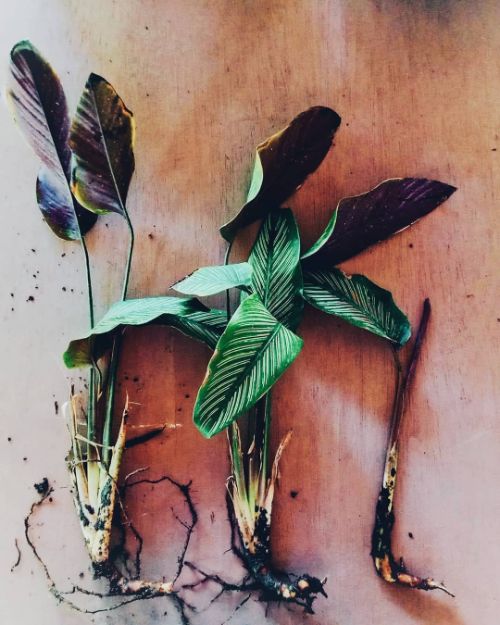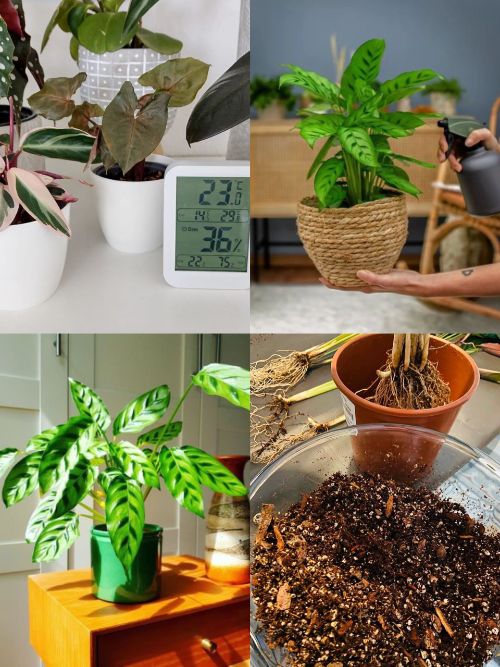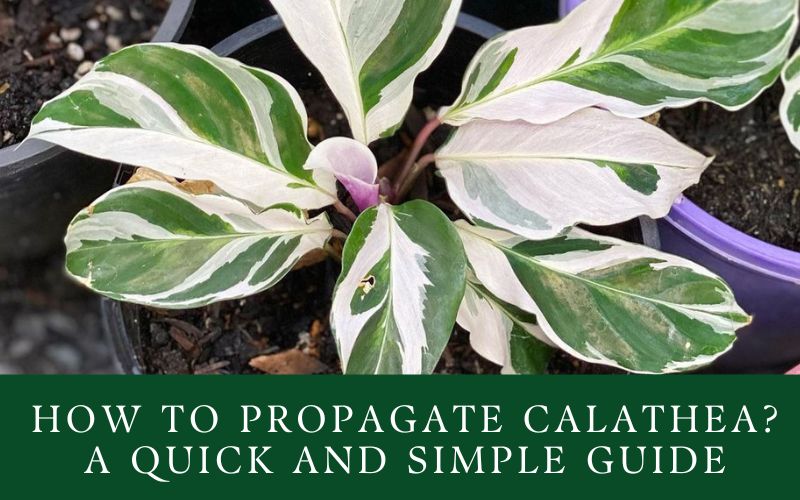Calathea, a cool plant from South America and Africa, often has fancy leaves with awesome patterns that catch your eye. But don’t let its beauty trick you — like many other tropical plants, growing more calathea from a parent plant can be a bit tricky, but really fun for any plant lover.
In this blog post, we’ll guide you on how to grow new calatheas from parent plants using cuttings or division. Keep reading to get easy tips on how to propagate calathea.
What is Calathea propagation and why do it
Calathea propagation is just a fancy way of saying growing new Calathea plants from existing ones. This can be done in different ways, like using stem and leaf cuttings, division, or tissue culture.
- Growing from stem and leaf cuttings means taking bits of a Calathea plant and putting them in water or soil to grow.
- Division means cutting off a piece of the root system from a Calathea plant and planting it in soil or water.
- Tissue culture propagation is done by taking little bits of stem tissue from a Calathea plant and putting them in a clean, nutrient-rich growing medium.
All these ways of growing more Calathea need time and care, but can be super rewarding and a great way to add to your Calathea collection. But remember, it might not always work and success rates will change depending on the method used and how healthy the existing plant is.
Why should you grow more of your calathea plant? Here are some reasons:
- Your Calathea has grown too big for its pot. It’s not a big fan of being repotted too much, so to avoid stressing it out, it’s a good idea to divide your plant when repotting.
- Growing more of your own calathea plant is good for the environment because it reduces the number of new plants that need to be grown and picked. Plus, you’ll always have a steady, healthy supply of plants.
- Growing your own calathea plants makes them easier to take care of since they’ll already be used to your environment, temperature, soil, and watering schedule.
- You can control how big your plant gets if you want it to stay a certain size.
- You can share the divided plants with your loved ones so they can enjoy them too.

Tools needed to prepare for Calathea Propagation
When it comes to growing more Calathea, having the right stuff is super important. Stuff you should have include:
- Sharp scissors or pruning shears – these will be used for cutting through the stem and root of your Calathea plant;
- A clean container filled with a mix of damp soil and sand – you can use this to plant your freshly-cut bits;
- Planting pots or trays – these will be used to make sure the cut bits have enough room to grow roots;
- A spray bottle filled with water – this is needed for keeping the soil damp during growth;
- A warm, sunny spot – your Calathea will need this to make sure it grows properly.
With these tools ready, you can now start the fun process of growing more of your Calathea.

The best season to grow more Calatheas
The best time of year to grow more Calatheas is usually during spring or summer when it’s warmer and the days are longer.
During these months, new bits of the plant grow fast and can be trimmed and rooted to grow new Calatheas. Your plant will bounce back faster from the stress of being split up.
You can gently divide the plant when you take it out of its pot to repot it. Since a lot of calatheas have fragile roots, you should handle them super carefully to avoid hurting them, which could slow down the growth of the divided parts.
Put your new divisions in new pots with fresh soil, and then give them as much humidity as you can. Cut back on the amount of light until active growth starts up again, which should happen in two to four weeks.
Every couple of years, your Calathea should be split up again and replanted in new potting soil.
How to grow more Calathea plant
Growing more of a Calathea Plant is relatively easy and can be done by division or cuttings or tissue culture. However, out of the three methods, only the division method is the most effective way to grow more calathea at home.
Because calathea plants don’t naturally have nodes like vining plants do, it’s pretty much impossible to grow them from stem cuttings or even from root cuttings. Calathea can be grown through tissue culture, but this method needs a bunch of fancy tools and chemicals that most of us just don’t have lying around.
So, growing more Calatheas is a great way to grow or multiply your existing houseplant collection. To grow more Calatheas, follow these steps:
- Pick a healthy parent plant that’s grown enough to be divided, making sure it has several strong shoots with lots of roots.
- Water the soil a lot to soften it and make division easier.
- Gently take the plant out of its pot, making sure to keep as much of the root ball whole as possible.
- Use a sharp knife or spade to divide the plant into pieces, making sure each piece has several shoots and some roots attached.
- Put the divided pieces in either a fresh potting mix or a mix of compost and perlite or sand.
- Water the newly planted pieces until the soil is damp and place in a light, warm spot with indirect sunlight.
- Keep a close eye on the baby plants to make sure they’re not drying out too fast or getting too much water.
- Once the plants have settled in, slowly move them into brighter, direct sunlight.
By following these steps, you can grow more Calatheas and add them to your houseplant collection. Growing more plants is a great way to increase the number of plants without having to buy them from a nursery or store.
To learn more about Calathea growth, please watch the following video:
How To Look After Calatheas After Propagation
Once you’ve successfully grown a new calathea, the next step is figuring out how to take care of it. Taking care of Calatheas after propagation means making sure they get plenty of light, watering them regularly, and using a soil mix that drains well.
- Calathea Watering: Water your Calathea regularly, making sure to keep the soil damp but not soaked. Let the top layer of soil dry out between watering to avoid root rot. Also, make sure that you’re using filtered or distilled water as hard water can leave white spots on the leaves of your plants.
- Calathea Light: Make sure that your freshly grown Calathea gets plenty of bright indirect light. An east or west-facing window would be perfect. Don’t put them in direct sunlight, as this can cause the leaves to get sunburned and change color.
- Calathea Soil: Use a soil mix that drains well for your Calathea and make sure you use a pot with drainage holes. A good soil mix for these plants is a mix of peat moss, perlite, and compost.
- Fertilizer: Feed your Calathea with a diluted liquid fertilizer every two weeks during the growing season. Doing this will help make sure your plant has all the nutrients it needs to stay healthy.
- Temperatures: The best temperatures for Calatheas should be between 65–80°F (18–27°C). If temperatures drop below 60°F (16°C), the leaves might start showing signs of damage, like turning brown or wilting. On the other hand, temperatures higher than 80°F (27°C) can also hurt the plants.
- Calathea Humidity: Humidity should also be thought about when taking care of Calatheas after propagation. The best relative humidity levels should be between 50–70%, as too much or too little moisture in the air can cause problems. Use a fan to make sure temperatures and humidity levels are balanced.

Common Problems Calathea Propagation
Common problems after growing Calathea include root rot, nutrient deficiency, diseases, pest problems, low temperatures, and not enough water.
- Root rot can happen if the rhizome gets too much water or doesn’t drain well.
- Nutrient deficiency can be caused by not enough light or bad soil mix.
- Diseases like powdery mildew or blight can attack Calathea plants if it’s too humid.
- Pests like aphids, calathea spider mites, and mealybugs can also be a problem for newly divided plants.
- Low temperatures can cause leaves to wilt and droop. Your Calathea may be showing signs of being too cold or caught in a draft. Move them somewhere warmer.
- Not enough water can cause leaves to wilt and turn yellow from dehydration.
It’s important to keep an eye on your Calathea after division to make sure it’s healthy and doing well. Proper maintenance like providing enough light, water, and fertilizer will help make sure a successful propagation.
If any problems do pop up, it’s best to tackle them fast and take steps to fix the problem. With the right methods and plenty of patience, you can have lovely new plants that will add life to any space.
Top Tips For Growing Calatheas
Growing Calatheas is an easy and rewarding task. Here are some tips to help you get started:
- Division propagation is the easiest way to grow more Calathea. All you need to do is wait for your Calathea to become root-bound and then carefully split it into two or more pieces, making sure each piece has some roots attached. Plant each piece in its own pot with fresh soil.
- To make sure your new plants get the nutrients they need, feed them with a balanced liquid fertilizer every two weeks during the spring and summer growing seasons. Remember to dilute it to half-strength when feeding your Calatheas.
- Always give your Calathea a good watering but be careful not to overwater or let the soil get soggy. Check for moisture before watering by feeling the top 1-2 inches of soil.
- Put your Calathea in bright, indirect sunlight and keep it away from direct sunlight to avoid leaf burn.
How To Propagate Calathea FAQs
Q: Can all Calathea Plants be Propagated?
A: Generally speaking, most Calathea Plants can be grown. However, some types of Calathea are tough to grow. To make sure you’re successful, it’s best to start with a healthy plant that’s been well-looked after before trying to grow more.
Q: Does Calathea Have To Be Healthy To Successfully Propagate?
A: Yep, it’s important to start with a healthy plant that’s been well-looked after to make sure you successfully grow more. Healthy plants are more likely to survive the process and will give better results. Be sure to check for any signs of bugs or disease before growing more of your plant.
Q: How Long Do The Divisions Of New Calathea Take To Establish?
A: Getting new pieces of Calathea established generally takes about two months after replanting. During this time, it’s important to make sure that the plant gets enough moisture and light to make sure it grows well.
Q: Can you propagate calathea plants in water?
A: For a bunch of reasons, you can’t grow Calathea in water. First off, it’s only divided and not really spread. That means that the new plants need the same soil as before. Second, putting the roots of Calathea in just water chokes them and makes root rot more likely.
Q: How long does it take a calathea plant to root after propagating?
A: Calathea plants generally take anywhere from two to four weeks to root. The exact timing can change depending on the type and size of plant, as well as things like temperature and humidity. In general, it’s best to provide enough warmth and humidity for the quickest rooting time.
Conclusion
All in all, growing more is a great way to add to your Calathea collection without having to spend money on new plants. By following the steps outlined in this blog post, you’ll be on your way to successfully growing more Calatheas.
Just remember to watch out for common problems that can happen during growing more and to give your newly grown Calatheas the care they need. With a little bit of patience and some practice, you’ll be a pro at growing more Calathea in no time! For more information on gardening and other houseplant care tips, be sure to check out Famiplants.

